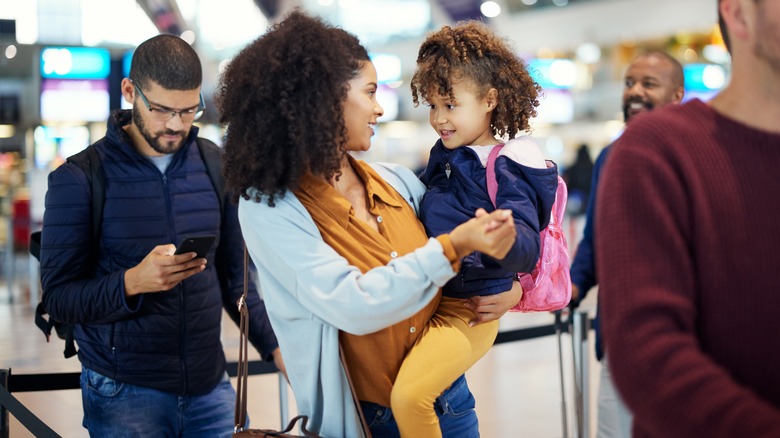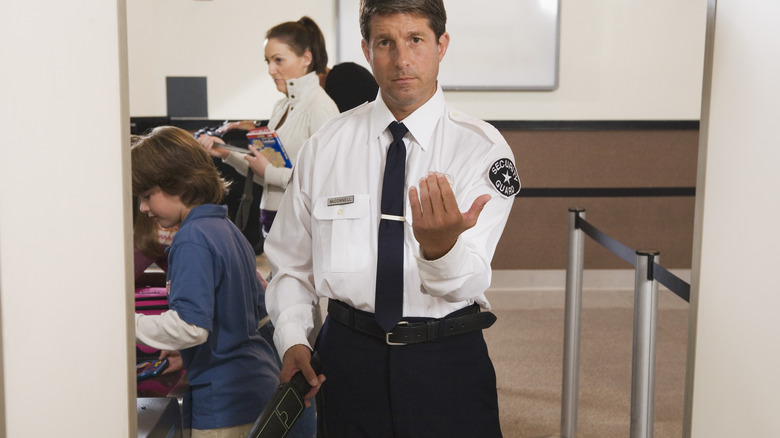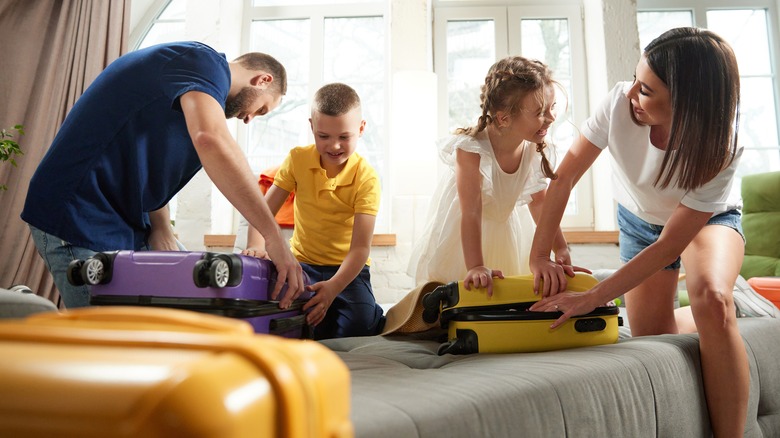Are Children Exempt From TSA Pat-Downs During The Screening Process?
Long lines, confusing rules, harsh officers — that's right, we're talking about airport security. Getting through the TSA checkpoint can be one of the most dreadful parts of traveling, and pat-downs only make the process more uncomfortable. Physical hand searches are required if screening machines detect a suspicious item or if a traveler can't or doesn't want to be screened by the machines. Additionally, some fliers may be randomly selected for a pat-down. Even if getting frisked is inconvenient or feels invasive, you can't refuse a TSA pat-down — and that's also true for children.
Generally, young passengers are given the option to walk through screening machines, reducing the need for manual searches. Metal detectors are available for children too young to walk (adults are allowed to carry infants and small children through the detectors) or stand still. Children who are comfortable standing still for several seconds are allowed to use advanced imaging technology scanners instead.
In many cases, a child will go through the metal detector or airport security body scanner without issue. However, additional screening is required if an unusual object is identified or the metal detector alarms. This can often mean a quick pat-down before your child is cleared.
What to expect during a pat-down of a child
Children under the age of 13 are subject to modified pat-downs different from the physical searches performed on adults and older children. However, TSA doesn't publicize exactly what modified pat-downs entail or how they vary from standard pat-downs. Still, you can generally expect a search of your child to be simple and minimally invasive.
Children are allowed to sit down or hold a caregiver's hand when receiving a pat-down. If they're uncomfortable or overwhelmed at the security checkpoint, the child (or you, on their behalf) can request a private screening instead. You or another adult companion is allowed to accompany the child to the private room during the pat-down. Whether you opt for a private screening or not, children should never be required to be separated from their parent or guardian.
Security personnel should remain professional during the pat-down and work with the child to keep them comfortable. However, if you believe a TSA officer crossed a line and behaved inappropriately during a screening, you can file a formal complaint. Report the incident using TSA's online form, providing as much detail about the event as possible.
How to prepare your child for TSA pat-downs
Since children aren't exempt from TSA pat-downs, it's a good idea to prepare them for physical searches, even if you're not sure if they'll actually need one. This can make the experience less surprising and scary for little ones. First, assure your child that they won't be left alone during any part of the screening process. Let them know that the security officers will never take them away and that you'll always be nearby.
If your child has a favorite toy or comfort blanket, warn them that the item will have to be put through the X-ray machine but that they'll get it back on the other side. This will reduce the need for pat-downs and help you get through airport security faster. If your child still requires a pat-down, inform them that the process is similar to being checked at the doctor's and that the security agent will apply a light touch to ensure everyone's safe for the flight.
Consider preparing your child for pat-downs long before you go to the airport. Small kids can benefit from role-playing activities, where you take turns acting as the TSA officer. You can even find informational videos online showing what the airport security experience is like. And while it may be easier said than done, taking steps to combat your own airport anxiety may also help ease your child's fears.


